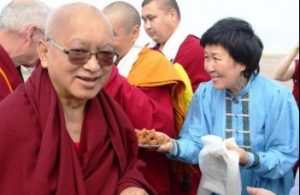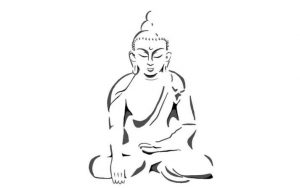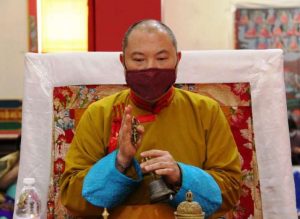Editor’s note: This feature was first published in the now-retired Bodhi Journal, Issue 1, October 2006.
How joyful to look upon the Awakened
And to keep company with the wise.
Follow the shining ones,
The wise, the awakened, the loving,
For they know how to work and forbear.
But if you cannot find
Friend or master to go with you,
Travel on alone
Like a king who has given away his kingdom
Like an elephant in the forest.
From The Dhammapada (cited in Lama Surya Das, Awakening the Buddha within, page 85)
I recall, in my childhood, poring intently over a large atlas and wondering about the teardrop shaped island then called Ceylon. I tried to imagine its people, the landscape, what it would be like to live there. Forty years later I am sitting in a bus traveling from Colombo, sharing with a group of fellow students from The University of Hong Kong a journey exploring preeminent Sri Lankan Buddhist sites. Bumping along down the road, I reflect on how the threads of our respective lives have come together at this point in time and how we are all on two simultaneous journeys whilst in Sri Lanka – the outward journey of places and sights and the inner journey of the spirit and the mind.
Our circular journey, which took us through Colombo, Anuradhapura in the north, Dambulla and Kandy, was filled with many amazing sights and experiences. To share some of the journey with those who were not able to join us, I have tried to highlight some of our daily experiences, providing a “snapshot” of our trip.
Day One – Colombo-Aukana-Anuradhapura
On the way to Anuradhapura we traveled “off the beaten track” to a quiet, isolated setting where the Aukana Buddha stands serenely, at one with the natural elements of the landscape. The Aukana Buddha is a 12 metre standing statute of the Buddha, the tallest standing Buddha statue in Sri Lanka, carved in the fifth century. The Buddha stands
reassuringly in the posture of abhaya mundra, dispelling fear and giving blessings to those who stand before it.
Anuradhapura – the dusty, sprawling ancient city of the Sinhalese kings that is revealed to us today, contains many treasures that reflect the central importance of Buddhism in the lives of the Sinhalese people. Buddhaghosa evidently also lived here in the sixth century AD. Its ancient treasures include:-
Sri Mah? Bodhi – A resplendent Bodhi tree decorated with colourful prayer flags that was grown from a cutting of the Bodhi tree under which the Buddha gained enlightenment. This cutting was brought to Sri Lankaby Mahinda’s sister, Sanghamitt?. The sacred tree is carefully tended by its guardians and is constantly surrounded by crowds of devoted people offering prayers, flowers and offerings. It is renowned as the oldest, historically significant tree in the world, having been planted over two thousand years ago.
Sam?dhi Buddha – A fourth century statue of Buddha seated in Sam?dhi. This Buddha is beautifully carved with a serene and peaceful visage – its serenity washes over its observers and has a mesmerizing quality. Nehru, the Indian politician, is said to have kept a photograph of this Buddha in his office.
Mahasena’s Palace – We viewed a well preserved and intricately carved moonstone. Venerable Dhammap?la, who accompanied us on our trip, gave us a detailed explanation of the symbolism of the figures in the moonstone, with the outer layer of carvings representing sa?s?ra, the inner layer depicting enlightenment and the whole piece illustrating Buddhist cosmology.
We visited a number of Dagabas (st?pas) in Anuradhapura. The most significant was the Thuparama Dagaba, the oldest st?pa in Sri Lanka, dating from the third century. It is believed to house the collarbone of the Buddha and is surrounded by a concentric cluster of stone pillars, giving the impression or a protective “forest”.
Day Two – Anuradhapura – Mihintale- Polonnaruwa- Dambulla
Our next major stop was Mihintale, the birthplace of Buddhism in Sri Lanka. It was here that Mahinda, son of the Indian emperor A?oka, spoke the word of the Buddha to King Devana?piyatissa ofAnuradhapura in 247BC, thus converting him. We climbed up an ancient staircase of 1,840 steps, lined on both sides with fragrant frangipani trees, to the Ambasthale Dagaba, which marks the place where Mahinda stood and spoke to the king. A mango tree stands near the Dagaba, symbolizing the Buddhist riddle Mahinda presented to King Devana?piyatissa.
Polonnaruwa – This city took over from Anuradhapura as the royal capital from the eleventh to thirteen centuries. Within the ruins of this once architecturally magnificent city, we explored the remains of royal palaces, dagabas and monasteries. We found a walking meditation passageway behind a huge fallen standing Buddha in a cathedral-like monastic building. It was a special experience to walk in the steps of those who had been here hundreds of years ago, contemplating the teachings of the Buddha.
Galvih?ra
Four Buddha’s are carved from one enormous piece of granite on the site of what was once part of a monastery built by one of the Sinhalese kings. There is something very special about this place. The Buddhas invite one to stop and reflect. As a group we naturally found ourselves sitting and meditating on the rocks facing the reclining Buddha. A small collection of people, who weren’t traveling with us, also joined us. Venerable Dhammap?la’s chanting seemed to fill the air around us, wrapping all of those sitting on the rocks in an atmosphere of deep reflection and mindfulness.
Dambulla Cave Temple
Another steep mountainside climb revealed a line of caves transformed into temples by King Valagamba, who sheltered within them when he was exiled from Anuradhapura. On reclaiming his throne, the King created these rock temples, resplendent with Buddhas and ornate frescoes. The temple itself dates back to the first century BC. Subsequent kings added further decorations and embellishments to the rock temples. The reclining fifteen metre Buddha in the first cave is an awesome sight. The feet of this Buddha are a special feature, ornately decorated with gold leaf and crimson concentric patterns.
The second cave, which is the largest, has a beautifully coloured fresco depicting important scenes in the Buddha’s life and historical events important for the Sinhalese people.
Again, this was another part of our journey that naturally inspired us to meditate and reflect. Circled around the lotus pool at the front of the caves we sat – still and peaceful. Fortunately our wonderful guide Frendy took on the task of discouraging a very cheeky monkey from grabbing our bags whilst we focused on our breathing!
Day 3 – Dambulla- Sigiriya- Aluvih?ra- Kandy
- Sigiriya (the Lion Rock) – The eighth wonder of the world and an UNESCO world heritage site. A 2 hour climb up to the top of this 500 foot volcanic plug revealed the ruins of a once magnificent royal palace and incredible panoramic views of the landscape. The rock itself is surrounded by gardens, and inner and outer moats.
Aluvih?ra – A rock monastery where the Tipi?aka was transcribed into P?li in the second century BC by 500 monks. An amazing feat of dedication, sadly destroyed by British troops in 1848. An older man in the nearby library showed us how the texts were scratched on dried palm fronds before being “inked” and bound together.
Day 4 – Kandy – Colombo
- Kandy
We arrived in the festive, crowded city of Kandy on the first day of the Kandy Esala Perahera festival, which celebrates the sacred tooth relic (a part of a tooth of the Buddha).
We woke at 4.30am the following day to go to the Temple of the Sacred Tooth Relic to visit the shrine containing the Buddha’s tooth, brought to Sri Lanka in a princess’ hair in the fourth century after it was taken from the Buddha’s mouth on his funeral pyre. This is probably the most important place in Sri Lanka , since the tooth has, over the centuries, become associated with the sovereignty of the country. The morning greeted us with a velvet blue sky as we followed a pathway to a temple complex festooned with electric lights. A guide ushered us into the inner sanctum of the temple, where the sacred tooth lies encased in a dagaba-shaped silver casket.
Kelaniya Raja Mah?vih?ra Temple
This temple stands in the spot where the Buddha is believed to have visited 2,500 years ago. The current temple was restored in the 18th and 19th centuries and features a series of detailed, colourful frescoes depicting scenes from the Buddha’s life and the first Tsunami that struck Sri Lanka as a result of the king boiling a venerated monk in a pot of oil.
Visiting Venerable Dhammajoti and dinner with Professor Anurudha.
One of the highlights for me on this trip was to visit the Buddhist Compassion Institute of Venerable Dhammajoti. After being served tea and bananas by some young novice monks, Venerable Dhammajoti gave us a teaching on meditation in the centre’s gompa. We then met Professor Karunadhasa and his wife for dinner in a Chinese Restaurant. Professor Karunadhasa’s kind and energetic company was a special way for our time inSri Lanka to be concluded.
Inner Journeys – Reflections on Buddhism and the Buddha’s teaching.
All of us on this tour had a common experience of the places we visited, yet everyone also traveled on an inner journey, inspired I think by many of those sights, places and people we connected with.
I would like to share one part of my inner journey on this trip. I grew up in Australia and had never heard of or thought about Buddha or Buddhism until hearing the Dalai Lama speak at a public gathering in the early 1990’s. Travelling to a country where Buddhism has flourished for thousands of years, observing the devotion of the Sri Lankan people at shrines and temples, talking with my fellow travelers about their experiences with Buddhism, experiencing the spiritual energy of various places we visited, and listening to the p?jas recited whilst traveling all enriched my own inner journey more than I could have ever imagined. For me the tour provided the catalyst for fusing the knowledge gained from my studies at The University of Hong Kong and my own readings on Buddhism with something deeper within my heart and mind. It is difficult to put that into words, however this quote from Herman Hesse’s novel ‘Siddh?rtha’ encapsulates for me the pathway of my inner journey in Sri Lanka and the difference this tour made in deepening my understanding of the Buddha’s teachings and their application to my life:
“A feeling of most profound love and most humble veneration burned like a fire in his heart. He bowed low, down to the ground, before the motionless sitting figure whose smile reminded him of everything he had ever loved in his life, of everything in his life that had ever been worthy and sacred for him.” (Page 117)
Resources
Lonely Planet guide to Sri Lanka
Herman Hesse, Siddhartha, Shambhala Publications, 2000
Lama Surya Das, Awakening the Buddha Within. Bantam Books, 1997















